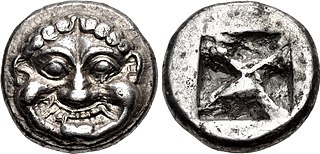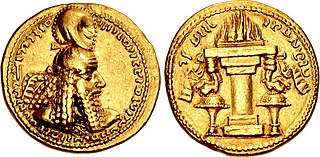The topic of this article may not meet Wikipedia's general notability guideline .(February 2019) |
The Samir Shamma Prize for Islamic Numismatics is a bi-annual award for the best book or article in the field of Islamic Numismatics.
The topic of this article may not meet Wikipedia's general notability guideline .(February 2019) |
The Samir Shamma Prize for Islamic Numismatics is a bi-annual award for the best book or article in the field of Islamic Numismatics.
The Royal Numismatic Society established the prize in 1992 following a legacy from Honorary fellow Samir Shamma. The prize of £2000 is awarded every two years for the book or article published within the previous three years that is considered the most useful to students of Islamic numismatics. [1]
Past recipients of the Samir Shamma Prize. [1]

The history of ancient Greek coinage can be divided into four periods: the Archaic, the Classical, the Hellenistic and the Roman. The Archaic period extends from the introduction of coinage to the Greek world during the 7th century BC until the Persian Wars in about 480 BC. The Classical period then began, and lasted until the conquests of Alexander the Great in about 330 BC, which began the Hellenistic period, extending until the Roman absorption of the Greek world in the 1st century BC. The Greek cities continued to produce their own coins for several more centuries under Roman rule. The coins produced during this period are called Roman provincial coins or Greek Imperial Coins.

The Royal Numismatic Society (RNS) is a learned society and charity based in London, United Kingdom which promotes research into all branches of numismatics. Its patron as of 2014 was Queen Elizabeth II.
Stefan Heidemann is a German orientalist at Hamburg University, Hamburg.
Jere L. Bacharach is Professor Emeritus, Department of History, University of Washington, Seattle, Washington.

Professor Ya'akov Meshorer was the Chief Curator for archaeology at the Israel Museum in Jerusalem and a prominent Israeli numismatist.
Gilbert Kenneth Jenkins was a leading figure in 20th-century numismatics. He was the post-war generation's most important expert in the study of Greek coins and medals and would become Keeper of Coins and Medals at the British Museum in 1965.

Joe Cribb is a numismatist, specialising in Asian coinages, and in particular on coins of the Kushan Empire. His catalogues of Chinese silver currency ingots, and of ritual coins of Southeast Asia were the first detailed works on these subjects in English. With David Jongeward he published a catalogue of Kushan, Kushano-Sasanian and Kidarite Hun coins in the American Numismatic Society New York in 2015. In 2021 he was appointed Adjunct Professor of Numismatics at Hebei Normal University, China.
Silk Road Numismatics is a special field within Silk Road studies and within numismatics. It is particularly important because it covers a part of the world where history is not always clear – either because the historical record is incomplete or is contested. For example, numismatics has played a central role in determining the chronology of the Kushan kings.

Marion MacCallum Archibald was a British numismatist, author and for 33-years a curator at the British Museum. She was the first woman to be appointed Assistant Keeper in the Department of Coins and Medals and is regarded as a pioneer in what had previously been a male-dominated field. Her 70th birthday was celebrated with the publication of a book of essays authored by 30 of her colleagues, collaborators and former students for whom Marion's name was "synonymous ... with the study of Anglo-Saxon coins at the British Museum".
David Michael Metcalf was a British academic and numismatist. He was the director of the Heberden Coin Room of the Ashmolean Museum, a fellow of Wolfson College and Professor of Numismatics at the University of Oxford. He held the degrees of MA, DPhil and DLitt from Oxford. He died in October 2018 at the age of 85.

Sasanian coinage was produced within the domains of the Iranian Sasanian Empire (224–651). Together with the Roman Empire, the Sasanian Empire was the most important money-issuing polity in Late Antiquity. Sasanian coinage had a significant influence on coinage of other polities. Sasanian coins are a pivotal primary source for the study of the Sasanian period, and of major importance in history and art history in general. The Sylloge nummorum Sasanidarum is the most important primary work of reference for Sasanian coins.

Elizabeth Jean Elphinstone Pirie was a British numismatist specialising in ninth-century Northumbrian coinage, and museum curator, latterly as Keeper of Archaeology at Leeds City Museum from 1960–91. She wrote eight books and dozens of articles throughout her career. She was a fellow of the Royal Numismatic Society, president of the Yorkshire Numismatic Society and a fellow of the Society of Antiquaries of London.
Sir Edward Stanley Gotch Robinson, FBA (1887–1976), usually known as (Sir)Stanley Robinson, was a numismatist, specializing in Greek and Roman coins. He was Keeper of the Department of Coins and Medals at the British Museum.
Colin Mackennal Kraay, FBA, FSA was an English numismatist. He was the Keeper of the Heberden Coin Room at the Ashmolean Museum from 1975 to his death in 1982.
Haim Gitler is an Israeli curator and researcher, specializing in the field of numismatics. He is chief curator of archaeology and curator of numismatics at the Israel Museum, Jerusalem, as well as the President of the Israel Numismatic Society.
Dorothy Boylan Waage was an American numismatist, who published the catalogue of 14,000 Greek, Roman, Byzantine and Crusader coins excavated by Princeton University in the 1930s. This has been described as "the best catalogue of Antiochene coinage".
Carmen Arnold-Biucchi is a classical numismatist and archaeologist. Born in Lugano, Switzerland, she studied classical archaeology and ancient history at the University of Fribourg, Switzerland, receiving her Magister in 1971. Her dissertation was on Cypriot terracottas. She is an expert on the coinages of Greek Sicily and Hellenistic numismatics.

Dorota Malarczyk is a Polish numismatist and Islamicist, who is a curator of the Emeryk Hutten-Czapski Museum, which is the coin cabinet of the National Museum, Krakow. In 2020 the Royal Numismatic Society awarded her the Samir Shamma Prize for Islamic Numismatics. She was a member of the Organising Committee for the 16th International Numismatic Congress in Warsaw. Research projects have included: Umayyad coins from Marea, inscriptions from the Kom el-Dikka graveyard in Alexandria, gems engraved with Arabic inscriptions and silver currency in tenth-century Europe.